
Marina District proposals swirled for a dozen years
City eager for action on east-side site
4/10/2011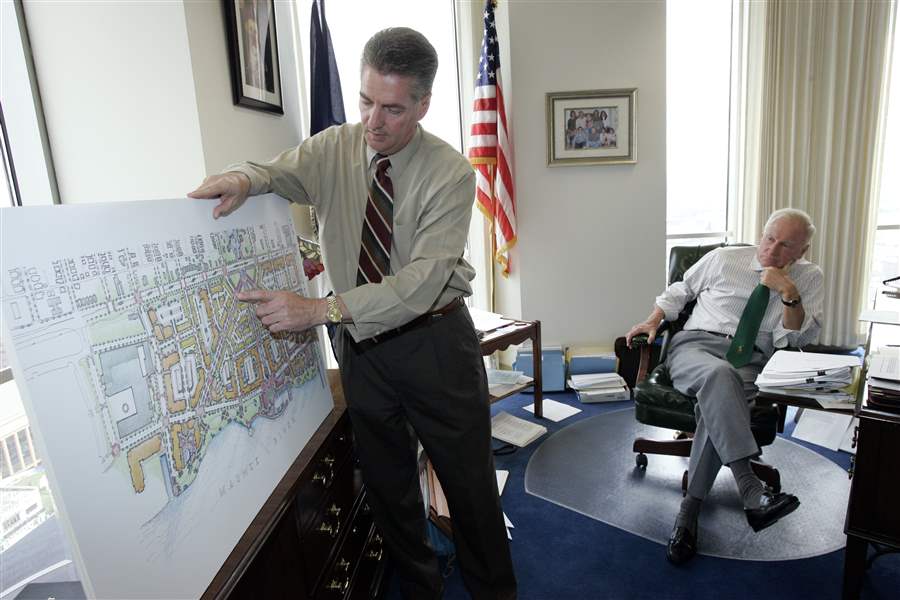
In 2008, Larry Dillin envisioned an urban beach and a pedestrian trail during his talks with then-Mayor Carty Finkbeiner.
THE BLADE
Buy This Image
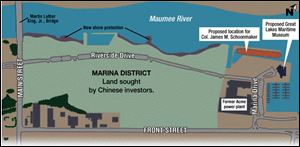
The Dashing Pacific Group, owned by Chinese investors, wants to buy 69 acres within the 125-acre Marina District along the Maumee River in East Toledo for $3.8 million.
A popular Internet video shows workers in Changsha, Hunan province, building a 15-story hotel in just six days.
In Toledo — more than 12 years of planning, promises, and $43 million of public money spent — the east side property called the Marina District is apparently close to getting its first private development.
"We look forward to the day when vertical growth occurs," Toledo Deputy Mayor of Operations Steve Herwat said.
Toledo has lined up new developers — apparently with a $3.8 million check in hand — who want to buy and build up the once polluted former industrial land along the Maumee River in East Toledo. After more than a dozen years of planning and several let-downs, most people are eager for some private development at the 125-acre site.
But exactly what will be built there by Chinese investor-owned Dashing Pacific Group Ltd., if City Council approves the sale, is still unknown.
Mr. Herwat said Mayor Mike Bell is satisfied that Wu Kin Hung and Yuan Xiaohona, both of China, have the wherewithal and capital to oversee and create a $200 million residential and commercial development and an "international village" at the site.
The Bell administration on Friday released legislation to sell 69 acres of the Marina District for $3.8 million to the company, which has already paid $2.15 million for the nearby Docks restaurant complex.
"The mayor has seen firsthand what they have done in China," Mr. Herwat said Saturday. "When it came to the sale of The Docks, $2.1 million in U.S. dollars was wired, we had a closing, and we took possession of those dollars."
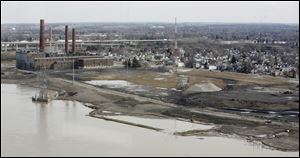
Under the proposed deal, the investors would have an option to buy the former Acme power plant, at left.
There is also a plan to move the preserved Great Lakes freighter SS Willis B. Boyer, renamed to its original moniker, the Col. James M. Schoonmaker, to the Marina District shoreline.
The history of the Marina District is complicated and stretches back to about 1997, when the city started assembling the land from private hands. Millions were spent to clean up environmental pollutants at the site, and after decades of industrial use, the 125 acres between Front Street and the river was deemed far too valuable to stay gritty.
Eventually a number of development ideas from multiple developers surfaced under the tenures of the previous two mayors.
Some on council are questioning if the public will get a say in Dashing Pacific's plan for the property and if they will use any of the past concepts from developers such as Larry Dillin, Frank Kass, and the Pizzuti Cos.
Mr. Dillin, the creator of Levis Commons in Perrysburg, was a previous Marina District developer who was pushed for years by former Mayor Carty Finkbeiner to get started with vertical construction almost up to Mr. Finkbeiner's last day in office on Jan 3. 2010.
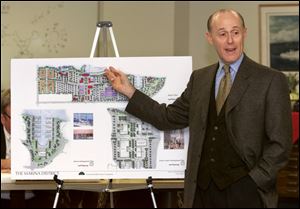
In 2000, developer Frank Kass presented a plan that included the construction of a sports arena.
"I am hopeful for Toledoans that the proposed concepts for the Marina District may finally come to fruition," Mr. Dillin said Saturday via Skype from Switzerland. "The groundwork laid from the joint efforts of the Finkbeiner administration and Dillin have provided a great road map for execution of a plan that should benefit Toledo for years to come if the master plan and its design controls are adhered to as envisioned."
Like Mr. Finkbeiner, Mr. Dillin wanted the project to incorporate the nearby East Toledo neighborhood — a collection of low-income and middle-class homes.
"The plans created previous to mine turned their back on the surrounding neighborhood. This was a serious flaw," Mr. Dillin said. "It is my strong belief that if the master plan does not connect both roadways, pedestrian uses, and amenities, like the redevelopment of Optimist Park, then the surrounding neighborhood will continue its certain decline into blight."
In October, 2007, the developer said he would build four-story apartment buildings with offices and retail stores at ground level that would center on a large public riverfront plaza that he likened to the Piazza San Marco — St. Mark's Square — in Venice. That portion of the project was estimated at $50 million.
The previous plan, proposed by the Pizzuti Cos. under Mayor Jack Ford, was focused on "big box" retailing and parking.

In 2008, Larry Dillin envisioned an urban beach and a pedestrian trail during his talks with then-Mayor Carty Finkbeiner.
Mr. Kass could not be reached for comment Saturday.
His concept was to include a larger arena to replace the more than half-century-old Toledo Sports Arena that was situated along East Toledo's Main Street. It has since been demolished.
The early Kass plan also called for the construction of 10 restaurants, 50,000 square feet of retail space, 200,000 square feet of office space, an 18-screen movie theater, 350 apartments, two hotels, and a marina.
Voter approval in 2001 enabled Toledo to financially back a $175 million riverfront development and a new sports arena in East Toledo. That vote allowed a one-time exemption of Section 79 of the Toledo City Charter, which bars city participation in building a sports arena without voter approval. The city was then able to contribute up to $8 million toward road and other infrastructure improvements related to the construction of a sports arena and other developments on the east bank of the Maumee River just north of The Docks.
But there were delays, Mr. Kass pulled out of the project, and then the Finkbeiner administration, followed by the Ford Administration, eventually dismissed the idea of having a new arena for the city on the east side of the Maumee River.
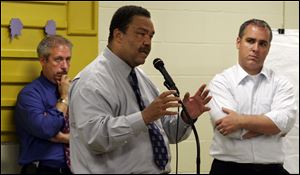
Then-Mayor Jack Ford, center appeared in 2005 with Jim Russell, left, of Pizzuti Cos. developers and Brian Parker, a representative of an arena consultancy, to discuss plans for the district.
Mr. Prephan will be paid a commission for the Marina District sale by the buyers, not the city, Mr. Herwat said. He was paid $107,500, or 5 percent, of the $2.15 million sale of The Docks from the city to Dashing Pacific.
The Chinese investors are not seeking any public support or tax abatements, Mr. Herwat said.
"I am not aware of any applications [for public support], and they have not asked for a tax abatement," he said. "There have been no demands from Dashing for the city or anyone else."
The Ohio Cultural Facilities Commission in July, 2009, approved a $4.9 million grant to be used by the city for the development of the Riverfront Park portion of the Marina District under the Dillin plan.
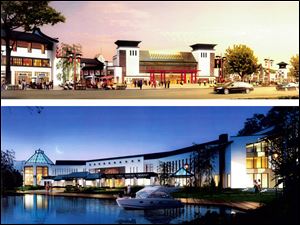
Dashing Pacific Group Ltd. has furnished conceptual drawings of potential development plans for the Marina District that include a mix of residential and commercial uses. The complex could have access by boat from the Maumee River.
Mr. Herwat on Saturday said Mr. Bell wants that money to be used instead for the museum, dredging, shoreline improvements, and moving the Willis Boyer, aka Col. James M. Schoonmaker,
"Ultimately, the state will make this happen, but that money is still out there and we believe it is an important project and we support it," he said. "The passenger terminal right now is underutilized, and moving the Boyer there makes sense."
Mr. Herwat added that the Dashing Pacific investors are aware of those plans and are supportive.
Contact Ignazio Messina at: imessina@theblade.com or 419-724-6171.